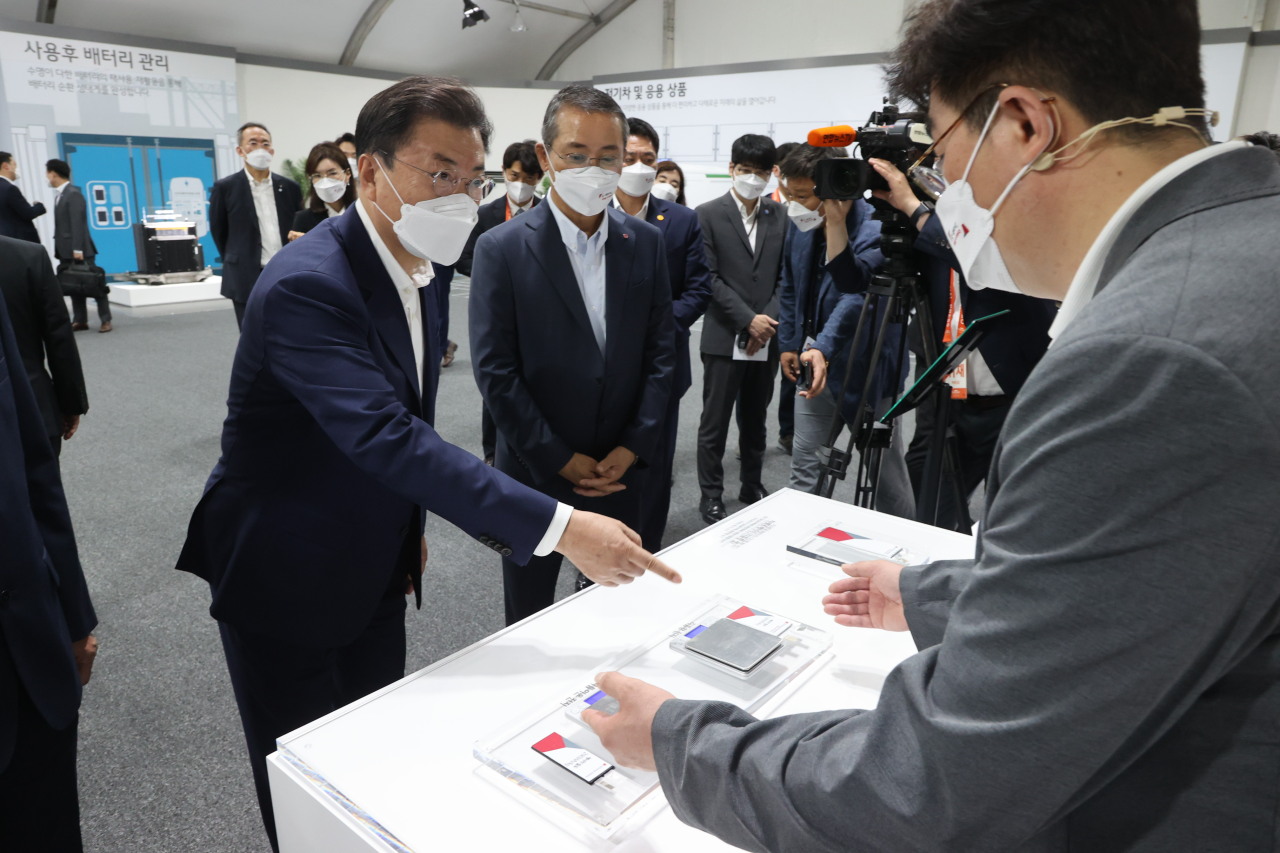Korea pledges W40tr investment for battery leadership
By Kim Byung-wookPublished : July 8, 2021 - 17:52

South Korea on Thursday unveiled an ambitious plan to consolidate its leadership in the white-hot battery industry, which included a plan by companies to inject over 40 trillion won ($34.9 billion) by 2030 as well tax incentives and other support from the goverment.
Dubbed the “K-battery strategy,” the public-private plan resembles one announced in March for the chip industry as Asia’s fourth-largest economy looks to sharpen its competitive edge in the face of growing challenges, including a global tug-of-war over strategic products.
“The K-battery industry is an essential industry that will open the door to the future. It’s an industry where we have been taking the global initiative, and it’s a field where we have to a secure a greater initiative,” President Moon Jae-in said at LG Energy Solution’s battery plant in Ochang, North Chungcheong Province, Thursday afternoon.
The event was attended by high-ranking government officials and representatives of top-tier battery firms, including LG Energy Solution, SK Innovation and Samsung SDI. The trio ranks among the world’s top 10 suppliers of lithium-ion batteries for electric cars.
“The global competition is just getting started, as the US, Europe and China are making moves to establish their own manufacturing infrastructure, battery technologies and supply chains,” an Industry Ministry official added, explaining the background of the national battery strategy.
“The next five years will decide the standing of each country in the global battery market. To engage in an all-out war, we devised a comprehensive strategy.”
The K-battery strategy revolves around three key objectives -- securing unrivaled battery technologies, establishing a robust ecosystem and creating new markets.
While the global electric vehicle battery market is projected to expand tenfold in the next decade, from $30.4 billion in 2020 to $304.7 billion in 2030, Korea and China are neck and neck in terms of market share, each controlling around 40 percent.
To gain dominance, Korean companies will invest 40.6 trillion won in the research and development of batteries to secure super-gap technologies, with plans to commercialize lithium-sulfur batteries by 2025, solid-state batteries by 2027 and lithium-metal batteries by 2028, according to the K-battery strategy.
Next-generation batteries often require new materials that can only be manufactured in tightly controlled environments. By 2026, Korea will construct a “battery park” equipped with dry rooms where researchers can develop and test next-generation batteries.
At the event, LG Energy Solution President and CEO Kim Jong-hyun, Samsung SDI research head Chang Hyuk and SK Innovation battery research institute chief Lee Jang-won gave presentations on strategies to advance lithium-ion batteries and develop next-generation batteries.
The K-battery strategy also laid out detailed plans to bolster the ecosystem of the local battery industry, as its supply chain remains highly volatile at the moment.
Lithium-ion batteries consist of four key materials -- cathodes, anodes, separators and electrolytes. Korea imports 47.2 percent of the cathodes it needs, 80.8 percent of the anodes, 69.5 percent of the separators and 66.2 percent of the electrolytes.
All four are made predominantly by Chinese and Japanese firms. Korea has a track record of getting into trade disputes with both countries.
According to B3 Intelligence, a market research firm, China and Japan together controlled 70.2 percent of the global cathode market last year. The figures were 91.7 percent for anodes, 80.3 percent for separators and 87.9 percent for electrolytes, it said, whereas Korea’s market share stood at only 19.5 percent for cathodes, 8.3 percent for anodes, 19.7 percent for separators and 12.1 percent for electrolytes.
The same goes for parts. China and Japan together commanded 99 percent of the global market for pouches, 54 percent for aluminum foil and 49 percent for copper foil. Korea’s presence in the pouch market is nonexistent, while it held 16 percent of the aluminum foil market and 20 percent of the copper foil market.
To turn things around, Korea will designate batteries as a national strategic technology and offer tax cuts of up to 50 percent for related research and development and up to 20 percent for infrastructure investment.
A fund worth 80 billion won will be launched to support research projects by startups and small and midsized companies.
In a related but separate announcement, LG Energy Solution unveiled a plan to establish the world’s first battery education institution. The LG Institute of Battery Tech will cultivate experts in the field.
To create new markets, Korea will establish a retrieval system that encompasses all stages of the post-treatment of spent batteries -- retrieval, collection, transportation, storage, diagnostics testing, use and commercialization. Dead batteries are expected to be repurposed and used to power street lamps and power banks for camping.
Also, Korea will roll out 2.2 gigawatt-hours of public energy storage systems and convert 388 state-owned ships to eco-friendly ones. Subsidies are planned for electric excavators to facilitate the electrification of construction equipment and machines.
To incubate battery lease and swap businesses, Korea will work on the standardization of batteries in terms of size, shape, voltage and other characteristics. By next year Korea will launch a pilot project for a “battery subscription service” that will allow customers to purchase empty electric vehicles for less than 20 million won and lease batteries.



![[Exclusive] Korean military set to ban iPhones over 'security' concerns](http://res.heraldm.com/phpwas/restmb_idxmake.php?idx=644&simg=/content/image/2024/04/23/20240423050599_0.jpg&u=20240423183955)

![[Graphic News] 77% of young Koreans still financially dependent](http://res.heraldm.com/phpwas/restmb_idxmake.php?idx=644&simg=/content/image/2024/04/22/20240422050762_0.gif&u=)



![[Pressure points] Leggings in public: Fashion statement or social faux pas?](http://res.heraldm.com/phpwas/restmb_idxmake.php?idx=644&simg=/content/image/2024/04/23/20240423050669_0.jpg&u=)









